A versatile, compact, and competent 12.3 MP Live MOS DSLR in the Four Thirds format, with lenses to match.
With the Olympus E-620 in hand, I combated intermittent bouts of pouring rain to photograph a league soccer game played in a local park. The rains here in New York had been incessant over the past few weeks, and who knew when I’d get another chance, since games are only played on weekends!
I began with the 40-150mm f/4~5.6 lens (= 80-300mm in 35mm format, given the 2X sensor factor)–one of two lenses that came in the kit. I progressed on to the 12-60mm f/2.8~4 SWD (= 24-120mm)–this one was added. SWD stands for Supersonic Wave Drive, designed as a faster and quieter technology driving AF functions. The other kit lens was a 14-42mm f/3.5~5.6 ( =28-84)–a lens I had little use for, given that this focal length range was covered by the more encompassing SWD zoom.
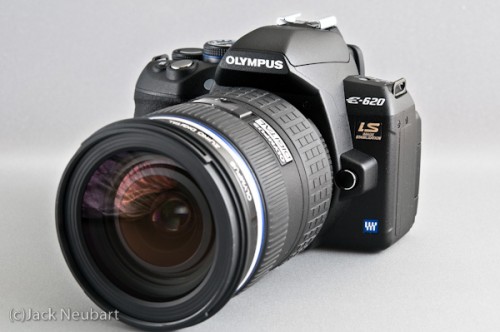
The kit lenses fall under the category “standard,” as Olympus defines them–largely under $500. These two are respectively in the $200 price range, when purchased separately (Olympus 40-150mm f/4.0-5.6 ED Zuiko Digital Lens for Olympus Digital SLR Cameras, Olympus ED 14-42mm f/3.5-5.6 Lens for Olympus Digital SLR Cameras). They are compact and lightweight. The 12-60 is a “high grade” lens. High grade lenses start around $500. The next level up is “super high grade.” They start at under $2,000, and the sky is practically the limit there.
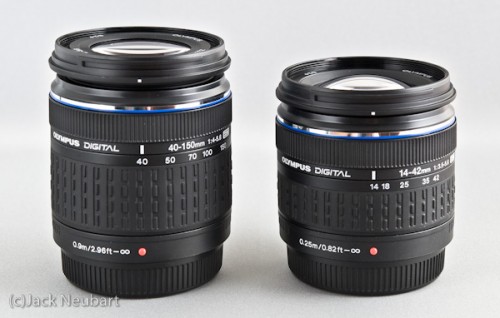
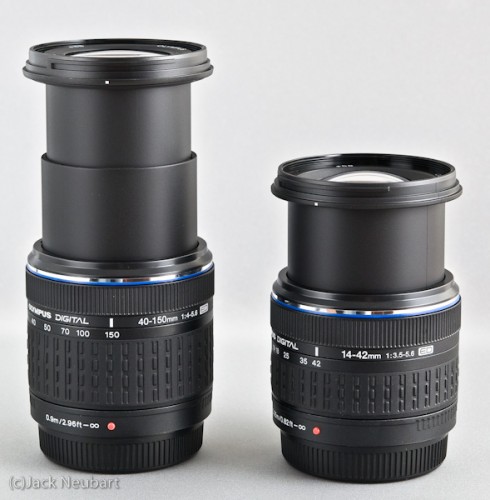
So, you’re probably wondering how my day photographing soccer went. Well, aside from almost getting hit by a soccer ball coming at me from the field and others from behind (people are playing soccer everywhere you look), not bad–not bad at all. But before I get into all the details, first…
Some Background on Four Thirds
You may have heard this before, but it bears repeating. The E-620 comes under the heading of the Four Thirds format. This is the first truly shared digital technology that lets you use lenses designed for this format with Four Thirds cameras produced by any partnering company. Unfortunately, each camera still has its own proprietary RAW file format–so this is not the pot of gold at the end of the digital rainbow. Or should we say, digital pot of gold at the end of the rainbow? Either way, it ain’t.
But getting back on topic, the Four Thirds format gives Olympus the opportunity to return to its roots–namely in the design and manufacture of smaller camera bodies and lenses with all the oomph of their larger counterparts. Admittedly, I found earlier Olympus digital SLRs less than awe-inspiring and they didn’t motivate me to be creative. Quite unlike the admirable OM-4T, which I’d used many, many moons ago, with dramatic results. That camera (shooting film, of course) helped open my eyes to many of the joys I experience in photography today.
Happily, the new E-620 goes a long way toward painting a rosier picture in the Olympus digital realm, and for the Four Thirds format as a genre. And at $800 (street price–in a kit with two zooms) (from Amazon, $749 Olympus Evolt E620 12.3MP Live MOS Digital SLR Camera with Image Stabilization and 2.7 inch Swivel LCD; from B&H, $799), this camera is a steal! The only thing missing is HD video, or any video capture, for that matter. It doesn’t mean that much to me now, but it might in the future. Something to consider…
But hey, look at that price again. Oh, if you want to start with different lenses, then the body is only $600. Really, now, you can’t do much better. And from the get-go, I will tell you that Olympus optics are among the best, so don’t think you’re compromising there. But are there any compromises to be made in this Four Thirds camera? That’s what we’re about to see. At the outset, I can say that the E-620 felt right in my hands the moment I picked it up. I was eager to get started.
Of course, with any camera system, the proof is in the optics that the camera surrounds itself with. As already noted, Olympus has maintained a long-standing reputation in this department. Since the lenses that fit one Four Thirds camera will fit all, thanks to a standardized lens mount (an “open standard”), there is a wide choice. Olympus leads the pack, followed by Sigma, with Panasonic trailing. And because all this glass and the camera body are designed around the Live MOS sensor, the optics are optimized to perform at their all-around best. To sweeten the pot, camera and lenses are firmware-upgradable.
What’s the E-620 Got to Say for Itself?
It swings. Well, for starters there’s that 12.3 MP Live MOS sensor. This Olympus/Panasonic variation on CMOS (more in name than a major technological breakthrough, to my way of thinking) is supposed to imbue the camera with mystical powers. Well, mystical they’re not. But functional, yes, very much so. To go with this Live MOS sensor is a 2.7″ Hypercrystal III Swivel LCD, which works admirably outdoors–at least under overcast conditions.
It sees live people. Face Detection in this camera tracks and latches onto up to eight faces in the frame, whether stationary or moving. Basically, you need it if you can’t tell the difference between a person and a piece of furniture. Thankfully, this camera doesn’t have smile detection. Otherwise, I’d never get a sharp face: I don’t know people who constantly carry a grin on their faces. Nor do I want to. I’m more into Mona Lisa smiles, and I’m not sure that smile detection technology is up to the challenge.
Tripod, be gone! When we encounter low-light situations, we often feel the need for a tripod or other firm support. That’s where image stabilization (IS) steps in, relieving us of the need to schlep around burdensome accessories.
Some cameras choose to limit image stabilization to selected optics. Olympus is among those companies that take just the opposite tack, building it into the camera so it can be used with any lens. Good or bad? Probably some of both. It no doubt sucks juice out of the battery, but didn’t seem to do any major damage.
Setting IS is simple–via a dedicated button. In fact, there are lots of dedicated buttons–again, good and bad, depending on how you play it. Anyway, IS was set to position 1, and, since that seemed to be working fine, I stuck to that setting. The other choices, aside from off, optimize IS for the direction of movement: horizontal or vertical–in other words, geared toward how you’re panning the camera.
However, you have to keep in mind that IS only works on the camera. It has no effect if the subject itself is contributing to the blur through movement or when you’re shooting at fast shutter speeds. It really only applies to relatively slow shutter speeds, preventing camera shake. When I was shooting the soccer match at speeds of 1/500 or better, IS was moot and inconsequential.
Better than an allergy pill. Olympus pioneered dust reduction in camera, with the aid of the Supersonic Wave Filter, which comes into play each time the camera is switched on. I didn’t have any dust problems, so I’d say it works.
And let’s not forget…The camera accepts the ubiquitous CF card as well as the I-don’t-understand-why-Olympus-is-still-hanging-onto-this-xD-memory-card. There’s also what’s called “shadow adjustment technology.” That’s another way of interpolating pixels to squeeze out as much of a tonal range as possible–in other words, a quick-and-dirty way to achieve a quasi (or should we say pseudo) HDR (high dynamic range), since this is applied solely to JPEG files (which makes it bogus in my book).
Beyond that are the normal range of exposure modes, shooting modes, and scene modes, plus some artsy-fartsy filters (much ado about little in this last group–also only applied to JPEGs). Noteworthy for you exposure freaks is highlight and shadow spot metering, although the camera doesn’t average multiple readings (boo-hoo). The camera also offers multiple exposures and automatically brackets ambient and flash exposures. And it supports wireless flash photography (wireless flash is a biggie for those of us into this stuff). And don’t overlook continuous shooting in bursts up to 4 fps. The list of functions goes on–seems endless, in fact. This really is a feature-filled camera, with tasty tidbits for you to discover and explore at every turn.
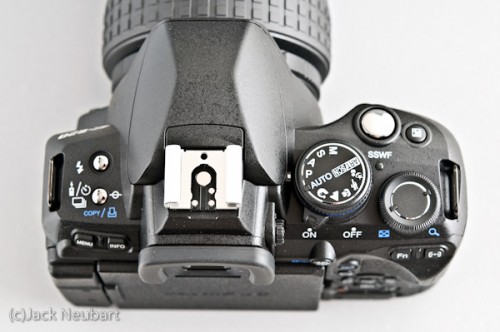
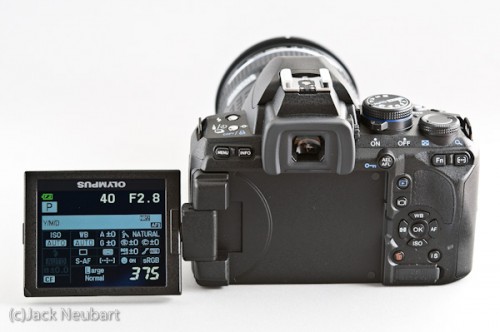
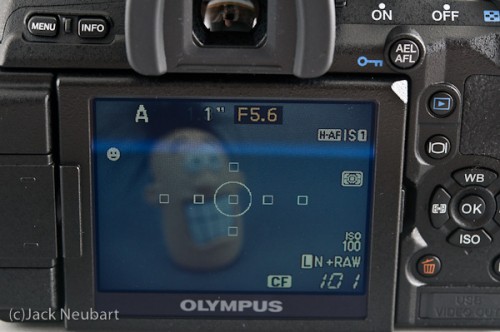
In the Field
I was immediately taken by the light weight of the E-620 and 40-150mm kit lens combined. Switching to the SWD lens added some heft. As mentioned, I set out to photograph soccer, and tried several different AF modes, finally settling on continuous AF, with Predictive AF sensing the direction of movement and automatically compensating for it. Unfortunately, I didn’t have time to stop and take notes, since every moment of clear weather was precious. But, judging from the pictures, I got an equal number of hits no matter which AF mode I used. While Face Detection was active, I didn’t always rely on it, considering the fast breaking action. To my way of thinking, Face Detection is geared more toward controlled environments or where movement is predictable, neither of which applied here. However, I must add that I did detect enough shutter lag to make me miss several vital moments in the game, even with focus locked in advance.
Autofocusing appears responsive enough, but is it the fastest on the planet? I have my doubts, considering the limited number of AF sensor points. It makes tracking action all the more difficult. I tried Live View, but since it’s not my preferred working mode, quickly returned to the optical viewfinder and my comfort zone.

During lulls in the game, I redirected my efforts to flowers and pigeons. There’s one shot of a pigeon frozen in flight thanks to the built-in flash. This shot is one of my faves taken with the E-620.
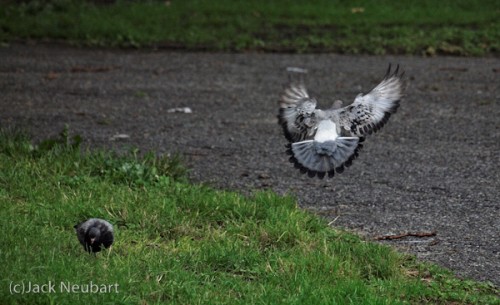
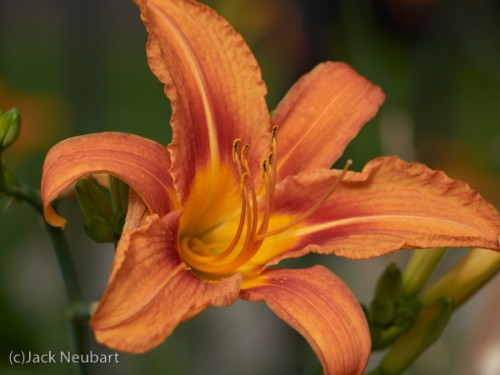
On another day I tested the “Art” filters. For the most part, they’re a waste of time. But the Pop Art filter did create some fetching color combos, and Soft Focus really seemed to imbue the image with a naturally soft quality ala a soft-focus filter, minus the halation effects normally associated with soft focus–which means this doesn’t really go as far as I’d like. And the Pin Hole effect is simply atrocious. They should have called this the Vintage Vignetting effect instead, because that’s what it is. A pinhole image is sharp front to back, in terms of depth of field (there is some image degradation owing to diffraction resulting from the tiny aperture–that part they seem to have got right). The Grainy Film effect produces grainy black-and-white images that are so contrasty that all highlight and shadow detail is lost–who would want this type of image, really!



Now, let’s turn to the lenses. Manual focusing was smooth with the 40-150mm lens, but these “standard” lenses use a focusing ring that knows no bounds: It continues to rotate, which can be frustrating when you’re trying to rack focus to either extreme. The SWD lens was only slightly better, with some resistance at either end. As for zooming, that proved much smoother on the less expensive lenses than on the pricey 12-60, which seemed to fight me as I zoomed. And for the price, I would have expected this SWD glass to have a fixed f/2.8 aperture. But images were quite good, although I seem to recall the Olympus OM lenses being punchier. While I did detect some distortion, it wasn’t disturbing enough in either the 12-60 or 40-150 to trouble me.
How effective is IS on this camera? Depending on whom you talk to, between 3 and 4 stops down from the optimum shutter speed. The optimum shutter speed with any lens is given as 1/focal length, which in this case should be multiplied by the sensor factor, 2–so that makes it: 1/(2 x focal length). Translation: at 30mm, you’d use 1/60 sec for a camera-shake-free shot, provided you observe good camera handling techniques (firm stance, gentle on the firing button). That means that with IS turned on, you can shoot blur-free down to 1/8 sec, or longer with this camera. (Note: Olympus says IS is effective for 4 stops-but 3 stops is a safer margin, according to my tests. Four stops would be a stretch. Still, it’s worth a try if it means getting the shot in some usable fashion or losing it altogether. And keep in mind, there is a limit to how far you can take image stabilization. I’d say one full second would be the max. But play around with it: You might take it further.)


All in all, I’ll admit that I found this to be an admirable system, with enough functionality to suit even the needs of the advanced amateur, while giving photo enthusiasts a camera they can use immediately sink their teeth into. If you’re a pro, you’ll find this a capable camera for travel photography.
The E-620 is priced modestly, even with the kit lenses added, which already makes it alluring. And the size and weight make the combo a dream package. Adding that this is a very capable performer is the clincher. I came away feeling my time with this camera system was time well spent.
Verdict: Buy it. The E-620 will take you in directions you want to go, and then some.
For more information, visit: Olympus America
Tech specs: at Olympus America
For more on the Four Thirds and Micro Four Thirds, visit: Four Thirds.
Tip: Check out the useful Olympus FAQs page on the Olympus E-620.
Other Recent Digital Camera Reviews on Photocrati
Nikon D700
Nikon D300
Nikon D90
Canon Rebel T1i
Canon Powershot G10
Olympus E-P1
Olympus E-30
Comparison: Full Frame Digital SLR Cameras
–
Go Home – Photography Blog
Chase
1 Jul 2009Now let’s say I’m a pro and I’ve already got a Nikon D700 or Canon 50D or something similar, with a full range of lenses. Is there any reason someone would buy the E-620 kit over a Nikon D40/5000 or Rebel XSi for casual travel photography? I feel like it’d be unnecessary for me to have two full sets of lenses that don’t work together, when I could get a small frame camera from Nikon or Canon that works with my lenses for roughly the same price?
billy
2 Jul 2009Chase, I feel as though the E-620 is an all-round better camera than the D40 Xsi’s of this world. If you are to use it as a casual travel camera as you say, then you are not going to want to put your D700 Pro lenses on it anyway. You would want small compact lenses, which this offers.
Chris
2 Jul 2009If you are already invested in glass, then no so long as you plan on utilizing the
with your travel setup. If you’re not heavily invested yet, the e-620 seems far better equipped in terms of build quality and options compared to the bodies you listed. There is talk of low light issues with the four thirds sensor, but unless you’re looking to move into the (expensive) realm of full frame sensors, the 4/3 is quite comparable to Sony/ nikon/ canon offerings in terms of quality. Color reproduction goes to Olympus hands down. People tend to argue over specs that aren’t used by 90% of photographers. Best scenario is to get all the cameras you may be considering in your hand and see what your gut feeling is. The camera that you will want to use and that you are willing to take with you is thebest one regardless of make. My Rebel always sat home, my e-420 felt great but the lack of IS frustrated me, the e-620 is always with me. Olympus’ new micro four thirds (the E-P1) is an incredible camera in terms of quality and portability. My best to all. (please excuse any typos as I am currently on the train and typing on my phone)
Stu
2 Jul 2009Depends upon whether you are concerned about lenses size and features as well as body size.
FF lenses on a D40/60 are not going to save you that much in size and weight when traveling, hiking, etc. So, unless you already have the smaller DX kit lenses, it might make sense. But, then, the 620 has a lot more features than the D40/60 series does.
As for the D5000, if that is the size you are looking for to have a travel camera (the D5000 being fairly large), then the lenses you take probably won;t matter. You are going to have quite a bit of size and weight already . And, in that case a small camera like the 620 probably doesn’t make sense.
Also, mating the 620 with the 12-60mm or 50-200mm probably isn’t going to make sense in that kind of case either. The travel solution, for me though, would be the 620 plus the 2 small, light and yet very good IQ kit lenses. 28-300mm in a very small, fairly inexpensive and very feature rich configuration.
But, it depends upon your needs and budget and can be a tough decision when thinking of a 2 mfr system.
Edwaste
2 Jul 2009Chase:
In the Nikon world you have the D5000 with the swing and tilt LCD. So the E-620 would not be necessary.
Sadly, Canon does not have such a camera. So a E-620 makes some sense.
IMO, live view is pointless without an articulating LCD. And that goes for the EP-1.
If you ever had to spend several hours laying down on a cold, hard, concrete floor to get that “right” shot…you would know what I’m talking about.
I’m so sold on the idea of such a configuration, I’m holding off any future purchases of a “full frame” camera until one is developed that has an articluating live view LCD.
alex
3 Jul 2009Well, Im not sold on the idea of an articulating screen. I use the lcd for one simple reason: its bigger! Also, it shows the live histogram, white balance and you can magnify it for manual focus. Frankly, Ive never moved the lcd screen around when I had a camera that had one. Why would one want to take pictures on the ground? Of bugs? Or over one’s head? I dont like crowds anyway, so I would never have occasion or need of an “articulating lcd” I like the fixed one on my camera just fine, thank you. At least I know it will never break, and I can use it just like I would the viewfinder– only much bigger and much more useful. Articulating lcd are toys that should have stayed on video cameras.
alex
3 Jul 2009Oh, and to the reviewer: more focus points doesnt make an AF faster, au contrare, it can actually make it slower, and imprecise, because it sometimes wont pick the point you want. Generations of film users did just fine with 3 AF points and many dslr users do so to this day– besides Imager still has its 11 points if you really need alot of AF points 😉
robminchin
3 Jul 2009Depending on your set of Nikon lenses, the D5000 might not auto-focus (no body-motor) – so there may be no advantage in sticking with Nikon for your light travel camera.
Edwaste
4 Jul 2009Alex:
If you like taking all of your shots from the same viewpoint, namely eyelevel…
good for you.
So I guess because YOU don’t need an articluating LCD screen, NO ONE should have one.
tio
25 Mar 2010People used to knock live view when only Olympus had it. As a macro shooter I knew anyone shooting macro in nature would find live view a revelation, fast or slow focus, w/ or w/o the articulating screen (another feature Oly introduced to DSLRs).
I haven’t held the E-620s competition, but the ergonomics, superior lenses, light weight, build quality, and uncrippled feature set (no mirror lockup on D40X, no spot meter on the Xti) made the 2 lens E-510 kit on sale for $550 a no brainer Xmas ’07. The Olympus felt like a precision instrument, the Canon like planned obsolescence w/ interchangeable lenses, with the Nikon splitting the difference. By all accounts the E-620 improves on the E-510 in every way.
Jack Neubart
25 Mar 2010Tio – thanks for your comment. We each have our own point of view. I personally prefer Nikon. The E-620 is good, but not great.
Jonaith
25 Mar 2010Hi their got a question, i already have an old e-410 for a while now thinking of upgrading the main body for the e-620 but the question is does it really worth the change? I never went to store to actually hold one, afraid of buy it and regret it. I got my interest in the IS system more then anything else since the size is really near my e-410 and think as staying with an olympus cause i already got some lense, flash and don’t want to buy that over once again ^^ Thank for your answer in advence.
Jack Neubart
26 Mar 2010Hi Jonaith – You have to ask yourself: Will a new camera give me anything I really need that my old camera doesn’t give me? If the answer is yes, then buy it. Also consider, how much are you currently invested in your photography. If you’re just a weekend snapshooter, then stick with the camera you have. If you want the latest technology and feel you can make good use out of it, then buy the new camera.
Just remember, manufacturers are always coming out with new products, so don’t kick yourself if you do buy a new one and they come out with something newer in 6 months, which they doubtless will.
laptop power cord
27 Jun 2010I think it will bring us more details which are closer to the reality than the former section. I agree with you that the camera will helped us to get many of the joys I experience in photography today. Besides, the HQ video is also amazing to us.
Ken
5 Apr 2011I am currently using An Olympus SP-570UZ. I like the size and large zoom. I also use an Olympus FL40 external flash, (necessary for weddings). I am generally pleased except for one feature: SHUTTER LAG. I take pictures of dogs and an occasional wedding and the shutter lag problem is very annoying. The review, (very well done), mentioned some shutter lag. Would the E-620 be better in this regard than my current 570UZ. I need something that is small with Zoom and minimal shutter lag. A dog jumping or the flower girl prancing down the isle in no time for shutter lag. Any suggestions or comments?
Jeff Jeffington
17 Sep 2012I have owned the 620 for a couple of years and am yet to get a pin sharp image with the kit lenses, Living in northern europe the suffiecent day light intensity required for this sensor happens only occasionally. May be if I moved to med latitude it would. I am very disapionted with the camera as a whole especially as I was a loyal 35mm oly user. I have tryed almost every setting I know and get frustrated by the results. i have even sent body back for checking. And yes i have tryed a an almost lab like studio setup to get the best results. Judging by the resale value of this system – less than £200 in 2012 I dont think I am alone in this verdict
beritagacor
20 Oct 2021i think i should buy it haha, thanks for sharing this information dude 🙂